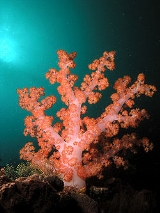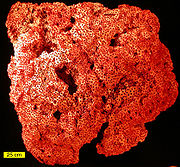
Alcyonaria
Encyclopedia
Octocorallia is a subclass of Anthozoa
comprising ~3,000 species of water-based organisms formed of colonial polyp
s with 8-fold symmetry. It includes the blue coral
, soft corals, sea pen
s, and gorgonians (sea fans and sea whips) within three orders: Alcyonacea, Helioporacea, and Pennatulacea. These organisms have an internal skeleton secreted by mesoglea and polyps with eight tentacles and eight mesentaries. As with all Cnidaria
ns these organisms have a complex life cycle including a motile phase when they are considered plankton
and later characteristic sessile
phase.
Octocorals are colonial organisms, with numerous tiny polyps embedded in a soft matrix that forms the visible structure of the colony. The matrix is composed of mesoglea
l tissue, lined by a continuous epidermis
and perforated by numerous tiny channels. The channels interconnect the gastrovascular cavities of the polyps, allowing water and nutrients to flow freely between all the members of the colony. The skeletal material, called coenchyme, is composed of living tissue secreted by numerous wandering amoebocytes. Although it is generally soft, in many species it is reinforced with calcarous or horny material.
The polyp is largely embedded within the colonial skeleton, with only the uppermost surface, including the tentacles and mouth, projecting about the surface. The mouth is slit-like, with a single ciliated groove, or siphonoglyph, at one side to help control water flow. It opens into a tubular pharynx
that projects down into a gastrovascular cavity that occupies the hollow interior. The pharynx is surrounded by eight radial partitions, or mesenteries
, that divide the upper part of the gastrovascular cavity into chambers, one of which connects to the hollow space inside each tentacle. The gonad
s are located near the base of each mesentery.
s, whereas the current order Alcyonacea was historically represented by four orders: Alcyonacea, Gorgonacea, Stolonifera, Telestacea.
The current phylogeny is shown below, where Calcaxonia and Holaxonia are groups of gorgonians and the four remaining divisions of Alcyonacea are merely distinguished for convenience.

Anthozoa
Anthozoa is a class within the phylum Cnidaria that contains the sea anemones and corals. Unlike other cnidarians, anthozoans do not have a medusa stage in their development. Instead, they release sperm and eggs that form a planula, which attaches to some substrate on which the cnidarian grows...
comprising ~3,000 species of water-based organisms formed of colonial polyp
Polyp
A polyp in zoology is one of two forms found in the phylum Cnidaria, the other being the medusa. Polyps are approximately cylindrical in shape and elongated at the axis of the body...
s with 8-fold symmetry. It includes the blue coral
Blue coral
Blue coral or Heliopora coerulea is a coral. It is the only species in the family Helioporidae and the only Octocoral known to produce a massive skeleton. This skeleton is formed of aragonite, similar to that of scleractinia...
, soft corals, sea pen
Sea pen
Sea pens are colonial marine cnidarians belonging to the order Pennatulacea. There are 14 families within the order; they are thought to have a cosmopolitan distribution in tropical and temperate waters worldwide...
s, and gorgonians (sea fans and sea whips) within three orders: Alcyonacea, Helioporacea, and Pennatulacea. These organisms have an internal skeleton secreted by mesoglea and polyps with eight tentacles and eight mesentaries. As with all Cnidaria
Cnidaria
Cnidaria is a phylum containing over 9,000 species of animals found exclusively in aquatic and mostly marine environments. Their distinguishing feature is cnidocytes, specialized cells that they use mainly for capturing prey. Their bodies consist of mesoglea, a non-living jelly-like substance,...
ns these organisms have a complex life cycle including a motile phase when they are considered plankton
Plankton
Plankton are any drifting organisms that inhabit the pelagic zone of oceans, seas, or bodies of fresh water. That is, plankton are defined by their ecological niche rather than phylogenetic or taxonomic classification...
and later characteristic sessile
Sessility (zoology)
In zoology, sessility is a characteristic of animals which are not able to move about. They are usually permanently attached to a solid substrate of some kind, such as a part of a plant or dead tree trunk, a rock, or the hull of a ship in the case of barnacles. Corals lay down their own...
phase.
Biology
Octocorals resemble the stony corals in general appearance and in the size of their polyps, but lack the distinctive stony skeleton. Also unlike the stony corals, each polyp has only eight tentacles, each of which is feather-like in shape, with numerous side-branches, or pinnules.Octocorals are colonial organisms, with numerous tiny polyps embedded in a soft matrix that forms the visible structure of the colony. The matrix is composed of mesoglea
Mesoglea
Mesoglea is the translucent, inert, jelly-like substance that makes up most of the bodies of jellyfish, comb jellies and certain primitive sea creatures in the phyla Cnidaria and Ctenophora. It acts as the creatures' structural support in water, as they lack bones or cartilage, endo- or...
l tissue, lined by a continuous epidermis
Epidermis (zoology)
The Epidermis is an epithelium that covers the body of an eumetazoan . Eumetazoa have a cavity lined with a similar epithelium, the gastrodermis, which forms a boundary with the epidermis at the mouth.Sponges have no epithelium, and therefore no epidermis or gastrodermis...
and perforated by numerous tiny channels. The channels interconnect the gastrovascular cavities of the polyps, allowing water and nutrients to flow freely between all the members of the colony. The skeletal material, called coenchyme, is composed of living tissue secreted by numerous wandering amoebocytes. Although it is generally soft, in many species it is reinforced with calcarous or horny material.
The polyp is largely embedded within the colonial skeleton, with only the uppermost surface, including the tentacles and mouth, projecting about the surface. The mouth is slit-like, with a single ciliated groove, or siphonoglyph, at one side to help control water flow. It opens into a tubular pharynx
Pharynx
The human pharynx is the part of the throat situated immediately posterior to the mouth and nasal cavity, and anterior to the esophagus and larynx. The human pharynx is conventionally divided into three sections: the nasopharynx , the oropharynx , and the laryngopharynx...
that projects down into a gastrovascular cavity that occupies the hollow interior. The pharynx is surrounded by eight radial partitions, or mesenteries
Mesentery
In anatomy, the mesentery is the double layer of peritoneum that suspends the jejunum and ileum from the posterior wall of the abdomen. Its meaning, however, is frequently extended to include double layers of peritoneum connecting various components of the abdominal cavity.-Mesentery :The...
, that divide the upper part of the gastrovascular cavity into chambers, one of which connects to the hollow space inside each tentacle. The gonad
Gonad
The gonad is the organ that makes gametes. The gonads in males are the testes and the gonads in females are the ovaries. The product, gametes, are haploid germ cells. For example, spermatozoon and egg cells are gametes...
s are located near the base of each mesentery.
Phylogeny
Octocorallia is considered to be monophyletic, that is all contained species are descended from a common ancestor, but the relationships between subdivisions are not well known. The sea pens (Pennatulacea) and blue coral (Helioporacea) continue to be assigned separate orderOrder (biology)
In scientific classification used in biology, the order is# a taxonomic rank used in the classification of organisms. Other well-known ranks are life, domain, kingdom, phylum, class, family, genus, and species, with order fitting in between class and family...
s, whereas the current order Alcyonacea was historically represented by four orders: Alcyonacea, Gorgonacea, Stolonifera, Telestacea.
The current phylogeny is shown below, where Calcaxonia and Holaxonia are groups of gorgonians and the four remaining divisions of Alcyonacea are merely distinguished for convenience.


